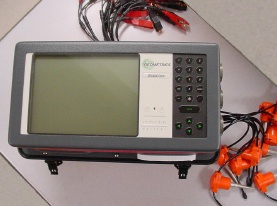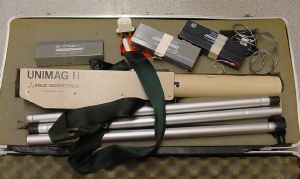


The EGR lab
houses a Geometrics StrataView
R-60 portable engineering seismograph. This 60-channel seismograph
operates with 24-bit analog-to-digital conversion and has networking capabilities
for integration with additional seismographs. The supporting seismic
equipment includes: 74 Mark Products 40-Hz geophones; 72 Electroteck 4-Hz
geophones; Mark Products reflection/refraction cables (1.5-m takeout intervals
w/24 takeouts per cable); three Mark Products jumper cables (80m and 2x40m);
several different sources (explosive and hammer); and miscellaneous accessories
necessary for collecting research and production seismic reflection and
refraction data from the upper 200 meters of the subsurface.
The EGR lab also has a Sensors & Software pulseEKKO100A Subsurface
Profiling System. This is a state-of-the-art, single channel ground
penetrating radar (GPR) unit. The supporting equipment includes100,
50, and 25 MHz surface antennas and a borehole GPR kit with 100 and 50
MHz borehole antennas. The GPR unit is driven with a Laversab Model
4024 NEMALite industrial (hardened) field computer.

The following additional geophysics equipment is available in the EGR lab: UniMag II Model G-846 portable proton magnetometer, Worden Prospector gravimeter Model III, BISON Model 2350A resistivity meter, SOILTEST Model MS-3 magnetic susceptibility bridge, and a gasoline-engine powered impact piston (used for drilling shallow boreholes).
Computationally, the EGR lab includes two SUN Ultra 5 333 MHz workstations (w/384 Mb RAM), a 400 MHz Macintosh G3 desktop computer, a 350 MHz Macintosh G3 laptop computer, a Laversab Model 4024 NEMALite industrial (hardened) field computer, and several other IBM-compatible computers--all of which are connected via Ethernet to a HP 4500N color laser printer. Three software packages are used for seismic and GPR data processing and interpretation: Seismic Processing Workshop (Parallel Geoscience), WinSeis seismic processing software (Kansas Geological Survey), and SeisUnix (Colorado School of Mines). All three packages are used to process and interpret seismic and GPR data, depending on the needs of the processor.
 Resources Available through the Department of Geology at the University
at Buffalo
Resources Available through the Department of Geology at the University
at Buffalo
The Department of Geology has a computing facility consisting of 16 SUN Ultra 5 333 MHz workstations. These workstations have 90% time availability for research (10% being used for teaching). In addition to use for geophysical data processing, the computers in the SUN lab are used for interfacing with the University at Buffaloís GIS facilities in the Department of Geography and the supercomputers in the Center for Computational Research (see below).
Other Related Resources Available at the University at Buffalo
I. National Center for Geographic Information and Analysis (NCGIA)
The NCGIA at the University at Buffalo is a National Science Foundation Center for research and applications of geographic methods, particularly in GIS, computer cartography, and spatial analysis. The Geographic Information and Analysis Laboratory (GIAL) is also available for research time as a multipurpose facility shared by the Department of Geography and the NCGIA. The GIAL lab allows full-time access to GIS software (including the ARC suite) for research use in data management and analysis.
II. The Center for Computational Research (CCR) at the University at Buffalo
The CCR is currently one of the top 10 academic supercomputing sites in the United States. This world-class computational research facility provides faculty with no-cost computational resources. The hardware includes: a Silicon Graphics Origin2000 system consisting of 64 processors connected in a shared-memory architecture, an IBM RS/6000 SP (48 processors), a Sun Microsystems Beowulf cluster consisting of 64 Sun Ultra 5 333 MHz workstations, and a high-end visualization systems from Silicon Graphics and Pyramid Systems.
III. The Multidisciplinary Center for Earthquake Engineering Research (MCEER)
The Multidisciplinary Center for Earthquake Engineering Research at the University at Buffalo is a is a national center of excellence. It seeks the reduction of earthquake damage and losses through research, development and application of new knowledge and advanced technologies.
